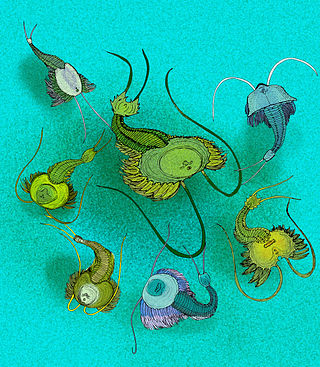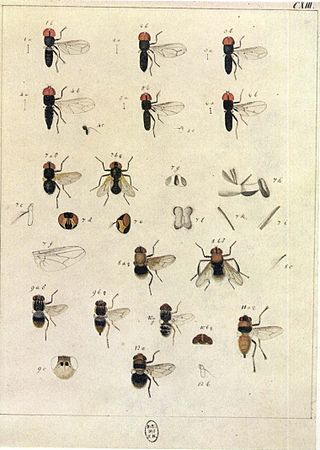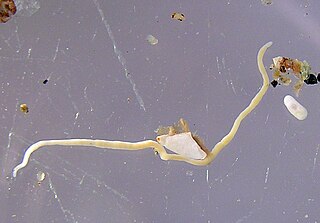
Kazacharthra is an extinct order of branchiopod crustaceans that appear to be closely related to the living order Notostraca. Kazacharthrans lived in marshes and ponds in the Upper Triassic of Western China and Mongolia, and in Lower Jurassic Kazakhstan. It is presumed that the kazacharthrids lived much like their living relatives, in that they were opportunistic omnivores that fed on any available food source, from bacterial biofilms to detritus to smaller animals that could be overpowered.

Aglajidae is a family of often colorful, medium-sized, sea slugs, marine opisthobranch gastropod mollusks. These are not nudibranchs; instead they are headshield slugs, in the clade Cephalaspidea.

Inca cuisine originated in pre-Columbian times within the Inca civilization from the 13th to the 16th century. The Inca civilization stretched across many regions, and so there was a great diversity of plants and animals used for food, many of which remain unknown outside Peru. The most important staples were various tubers, roots, and grains. Maize was of high prestige, but could not be grown as extensively as it was further north. The most common sources of meat were guinea pigs and llamas, and dried fish was common.

Nectandra is a genus of plant in the family Lauraceae. They are primarily Neotropical, with Nectandra coriacea being the only species reaching the southernmost United States. They have fruit with various medical effects. Sweetwood is a common name for some plants in this genus.

Unionopterus is a genus of eurypterid, an extinct group of aquatic arthropods commonly known as "sea scorpions". Fossils have been registered from the Early Carboniferous period. The genus contains only one species, U. anastasiae, recovered from deposits of Tournaisian to Viséan stages in Kazakhstan. Known from one single specimen which was described in a publication of Russian language with poor illustrations, Unionopterus' affinities are extremely poorly known.

Nipponacmea is a genus of sea snails, the true limpets, marine gastropod mollusks in the family Lottiidae.

Erginus is a genus of sea snails, true limpets, marine gastropod mollusks in the family Erginidae.

Monostilifera is a suborder of nemertean worms belonging to the class Enopla, a class of worms characterized by the presence of a peculiar armature of spines or plates in their proboscis.

The Nitschkiaceae are a family of fungi in the Ascomycota, order Coronophorales. Species in the family are mostly saprobic on wood, although some grow on lichens.
Garveia is a genus of cnidarians belonging to the family Bougainvilliidae.

Chalarus is a genus of flies belonging to the family Pipunculidae.
Dinonemertidae is a family of worms belonging to the order Polystilifera.
Uniporus is a genus of worms belonging to the monotypic family Uniporidae.

Pelagonemertidae is a family of pelagic nemerteans belonging to the order Polystilifera.
Tetrastemma is a genus of nemerteans belonging to the family Tetrastemmatidae.
Eolepadomorpha is an extinct order of barnacles in the class Thecostraca. There are 2 families and about 14 described species in Eolepadomorpha.

Microglyphis is a genus of gastropods belonging to the family Ringiculidae.
Oerstedia is a genus of worms belonging to the family Oerstediidae.

Ototyphlonemertes is a genus of worms belonging to the family Ototyphlonemertidae. The distribution of members of this genus includes Eurasia.

Zygonemertes is a genus of worms belonging to the family Zygonemertidae.













